Introduction
Welcome to the world of industrial style, a trend that has been winning hearts and spaces all over the world. Originating from a pragmatic need, this style is characterized by its robust simplicity and an aesthetic that speaks of history and functionality. In compact apartments, the industrial style offers a unique solution for those looking for a modern yet cozy design. Its key elements, such as the use of metal, wood and exposed brick, are perfect for creating a sense of spaciousness and light, essential in smaller spaces. In addition, the flexibility and practicality of the industrial style make it ideal for compact apartments, where every inch counts. In this guide, we will explore how you can incorporate the industrial trend into your own space, transforming your small apartment into a stylish urban retreat.
History of Industrial Style
The industrial style has its roots in the factories and warehouses of the 19th century, especially in the post-industrial revolution era. Initially, it was not an intentional design style, but rather a practical response to the need for large, functional workspaces. These environments were characterized by high ceilings, large windows, exposed metal structures, and exposed brick surfaces. Over time, especially in the last decades of the 20th century, these vacant industrial spaces in urban areas began to be converted into loft residences. This movement began the transition of the industrial style from the corporate world to the residential world. It became a design statement that celebrates raw, unfinished beauty, bringing a touch of modernity and history to interior design. Today, the industrial style is widely adopted in apartments and houses, adapting with elegance and personality to modern living spaces.
Characteristics of the Industrial Style
Industrial style is recognized for its raw, unfinished aesthetic that celebrates function as much as form. At the heart of this style are key elements such as brick, metal and wood, each contributing to a unique, textured atmosphere. Exposed brick, often in natural tones or painted white, creates a sense of rustic charm. Metal, whether in exposed piping, framing or decorative details, adds a modern, industrial touch. Wood, often used in its most natural, rustic state, brings warmth and balance to the design.
Furthermore, the industrial aesthetic is marked by minimalism and practicality. Furniture and decorations are chosen with a focus on utility, avoiding excess ornamentation. This approach not only emphasizes the intrinsic beauty of the materials and structures used, but also creates spaces that are both aesthetically pleasing and highly functional. The industrial style, therefore, is a perfect choice for those seeking a contemporary environment that combines history, simplicity and practicality.
Adaptation in Small Spaces
Adapting industrial style to compact apartments can seem like a challenge, but with smart strategies, it’s possible to create a stylish and functional space. The key is to choose and position the elements correctly to maximize space without sacrificing style.
First, consider using multifunctional and modular furniture. These items are ideal for small spaces because they offer flexibility and can be adapted as needed. For example, a coffee table that converts into a dining table or a sofa bed are excellent choices for saving space without compromising on style and comfort.
Incorporating open shelving and cabinets with clean, simple lines also helps to keep the space feeling open and airy, which are key features of the industrial style. Make the most of vertical space with tall shelves and cabinets that reach all the way to the ceiling, not only providing more storage space but also creating the illusion of a higher ceiling.
Finally, when integrating industrial style into limited spaces, it’s important to stick to a neutral, harmonious color palette. Light, neutral colors visually expand the space, while touches of metal and wood maintain the industrial essence. With these strategies, even the smallest of apartments can display a modern, welcoming industrial charm.
Choosing Furniture and Accessories
When selecting furniture and accessories for an industrial-style apartment, the choice of materials plays a crucial role. Look for pieces that incorporate iron, steel, raw wood, and concrete, materials that are typical of the industrial aesthetic. For example, a reclaimed wood coffee table with metal legs or steel shelving are perfect options for bringing a touch of authenticity.
When it comes to accessories, less is more. Opt for items that not only complement your style, but also serve a practical purpose. Industrial-style metal light fixtures, large wall clocks with exposed gears, and urban or geometric-themed art can add personality to your space without overwhelming it.
Another element to consider is texture. Rustic rugs, linen pillows, and natural fabric curtains can soften the raw look of industrial style, providing a balance between rough and comfortable. When selecting furniture and accessories, remember that industrial style celebrates the beauty of imperfection and functionality, so choose pieces that speak to this aesthetic in an authentic and harmonious way.
Lighting and Colors
Lighting plays a crucial role in industrial style, not only functionally but also as a design element. Metal ceiling lights, with a design reminiscent of old factories or warehouses, are ideal choices. For a more subtle approach, use metal track lights or pendants. Lighting should be focused, highlighting architectural elements and art pieces.
When it comes to colors, the industrial style favors a neutral, earthy palette. Shades of gray, white, black, and brown are commonly used, as they help create a sense of space and continuity. For compact apartments, it is recommended to use lighter colors on the walls to increase the feeling of space. Accents in darker or brighter colors can be added through accessories or furniture, but always in moderation. This combination of lighting and color not only enhances the industrial style, but also helps to create a cozy and spacious atmosphere.
Space Organization and Optimization Tips
Organizing and optimizing space are essential in compact apartments decorated in an industrial style. An effective solution is to use furniture that offers smart storage. Opt for pieces such as beds with built-in drawers, coffee tables with shelves, and cabinets that take advantage of the height of the walls. Make the most of vertical walls with open shelves, which, in addition to storing objects, allow you to display decorative items. Boxes and baskets made of materials such as metal or natural fabrics can be used to keep small items organized, maintaining the industrial aesthetic. Maintain daily organization by following the rule “less is more”: regularly evaluate and remove items that are no longer useful or that do not contribute to the decor. These practices will help keep your industrial space not only stylish, but also functional and pleasant.
Case Studies / Examples in Residential Areas
Exploring case studies and real-world examples is an excellent way to understand how the industrial style can be adapted to residential environments, especially compact apartments.
- Urban Loft in New York: This one-bedroom apartment transforms a limited space into a sophisticated and functional abode. Using elements such as exposed brick, exposed ceiling pipes and a neutral color palette, the design manages to visually expand the space. Multi-functional furniture, such as a sofa bed and a fold-out table, makes the most of the available space.
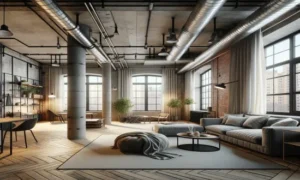
- Modern Studio in San Francisco: Here, the industrial style is presented in a minimalist way. Highlights include metal lighting fixtures and a kitchen with stainless steel cabinets. The apartment uses open shelves for storage and decoration, keeping the space organized and visually appealing.
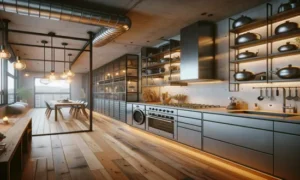
- Eclectic Apartment in Berlin: This example combines industrial style with pops of bright color and contemporary art. Elements like exposed concrete and raw wood furniture are softened by colorful rugs and wall art, demonstrating how industrial style can be personalized.
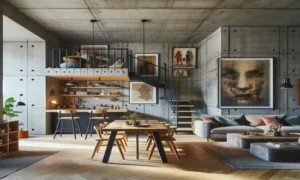
B. Examples of Successful Implementations
- Warehouse Conversion in London: A former warehouse has been transformed into a stunning home, retaining original features such as large windows and high ceilings. The addition of modern furniture and clever lighting has created a space that is both a tribute to its industrial past and a contemporary abode.

- Minimalist Apartment in Tokyo: This Japanese apartment uses industrial style in a subtle way, with polished concrete floors and built-in metal cabinets. The design is complemented by soft lighting and minimalist furniture, proving that industrial style can be serene and inviting.
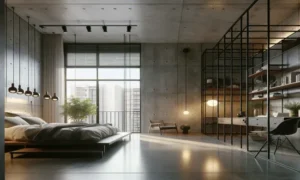
- Apartment Renovation in Barcelona: Here, a small apartment has been revitalized with an industrial-chic approach. Exposed brick walls and metal beams are combined with modern furniture and vibrant art, creating a dynamic and welcoming environment.
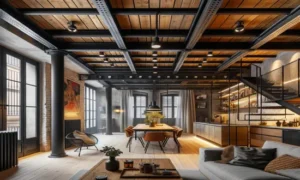
These case studies and examples demonstrate the versatility and appeal of industrial style, even in limited spaces. They offer practical inspiration for those looking to incorporate this unique style into their own homes.
Conclusion
In short, industrial style in compact apartments is a charming fusion of functionality, history, and modern design. With careful selection of materials, multifunctional furniture, and the right color scheme and lighting, you can transform your small space into a stylish and welcoming space. Remember, the key to successful design is balancing the industrial aesthetic with practical space and organization solutions. I encourage you to experiment and personalize this style, creating a space that not only reflects your personality but also meets your daily needs. Get creative and have fun decorating!
